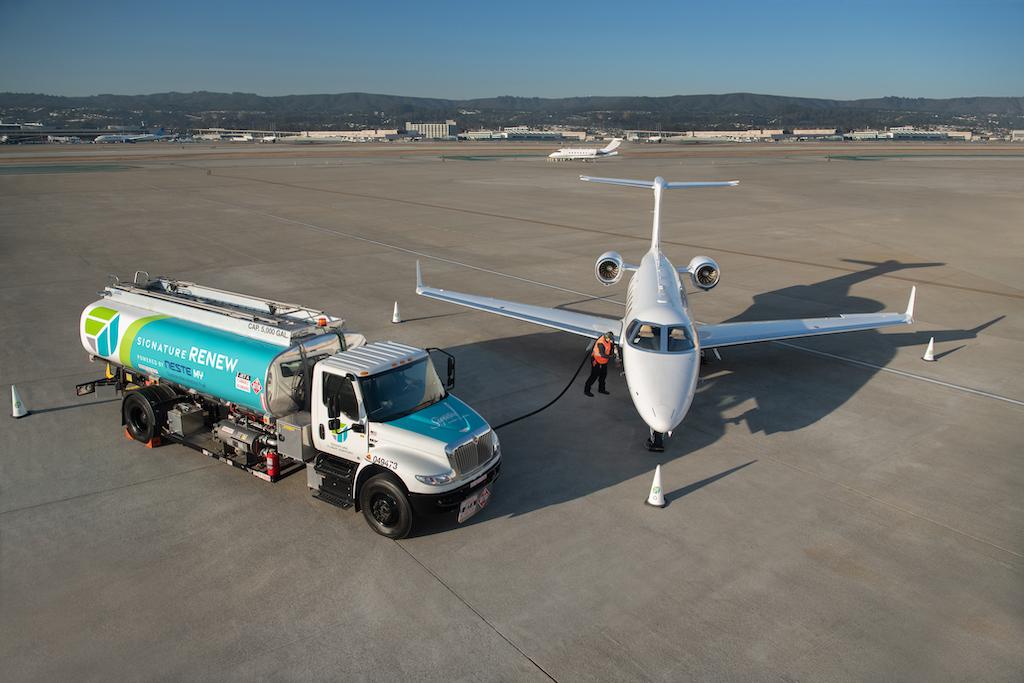
Marty Kretchman, Signature Flight Support’s senior vice president of operations planning, talks with BCA Editor Lee Ann Shay about its sustainable aviation fuel projections, as well as its book & claim program.
What is Signature Flight Support’s plan for increasing use of sustainable aviation fuel (SAF)? What volume is available now and what are you hoping to increase it to in 2022?
We announced at NBAA-BACE that we hit the 4-million-gallon mark (SAF gallons pumped since September 2020), and since we’ve hit the 5-million-gallon mark. We continue to pump thousands of gallons per day and our commitment is only growing. We’ve got seven airports with a permanent supply that we’ve announced so far and we plan to announce more early in 2022. We want to continue to be the leader in the GA space in terms of volume delivered. There are lots of headlines around SAF and a lot of folks are doing demonstration-type loads. We’re the only one with this rate and volume, and we’ve committed to buy it even if we don’t have customer commitments because we see a lot of interest and converting that to demand is taking a little longer. I think people are trying to learn about the product: what does it mean, how does it help them meet their climate and carbon reduction commitments. The key is having the SAF supply available in the marketplace, but we also have to continue to drive the cost down for operators and continue to educate customers, and Signature is very committed to all three of those.

What is the price of a SAF gallon and how long will it take to get the SAF price to an equilibrium?
It varies and depends on the market, but you’re looking at a premium of about $1 per gallon of a blended gallon versus conventional jet fuel. But you get the additional value of receiving credit for the reduced carbon intensity. Our goal at Signature, and as an industry, is to continue to drive down that price in the next couple of years. I don’t know if it’ll ever get exactly there, but I think the less of a spread, the more of a market there will be for it. It’s a different product only in the sense that it provides additional value—it meets the same standards as conventional jet fuel. Helping people understand that is key. It’s hard to predict how quickly we will get that premium down, but getting more volume into the system only benefits that.
What are your projections for SAF volume and how do you balance supply versus demand? For instance, you might want 30 million gallons but only 20 million are available.
We’re trying to buy as much of it as we can because we see this growing demand from our customers. It will be more than 5 million. I would love to have 30 million next year, but you made this point which I’ll endorse. It would be hard to probably get 30 million gallons next year, but we’ll do everything we can to support companies that are producing it. There is some additional production coming online this year and in the subsequent years that’s been announced, including by some major conventional petroleum players such as Air BP and Total, so that will only help to increase capacity. But yes, somewhere north of 5 million.
Do you ever get into a bidding war with airlines because there is limited supply? For instance, in San Francisco, are you competing against United Airlines for SAF?
I wouldn’t say a bidding war. It’s been pretty friendly. But you highlight a key point: airlines have been very active in securing volume for several years, including United, amongst others. For us, it’s getting GA a seat at the table. We’ve been successful doing that. A few years ago, nobody would have thought GA would take 5 million gallons, but we have and that has certainly gotten us noticed as a company and now as an industry.
But we are competing with the airlines for this volume. They were ahead of us as an industry. And there’s a little bit of catch-up being played here. But I think there will be plenty to go around and I think it takes operators like Signature to make commitments to make this market happen. I think people are always willing to produce things that you’re willing to buy, right? It took us being willing to go out in front and say look, we will commit to these millions of gallons. We’ll buy it and then we’ll work to educate and sell to our customers, versus people thinking, once customers want it, we’ll start to refine it. That was a little backward. And I think that’s why we’ve had a bit of a slow start, but our commitments are starting to create some more momentum from the producers in general aviation, which is a good thing.
Where are customers with book & claim? Does that have momentum too?
At NBAA-BACE, Signature announced its book & claim program that is about not needing to physically get SAF to every location for customers to be able to buy it and get the benefit. Let’s say someone in New York wants SAF but you have to transport it via truck from where its refined in California. The carbon intensity of moving that fuel across the country in a truck burning nonsustainable diesel fuel impacts the benefit of that sustainable aviation gallon and ultimately ends up being worse than the operator using a conventional gallon by the time that truck gets it across country. So we realized early that book & claim was key to the marketability of the product to make it available at more places, but also ultimately to have the greatest benefit toward sustainability, if we can deliver a gallon in the least carbon-intensive way possible, but still create that market benefit for our customer where they can acquire the product. That is the ultimate win-win. Right now there are a few locations that can offer it from the front desk, probably three or four, but what we’re looking to do is to sell book & claim credits at any location for any flight, at our FBOs or others, so operators can buy that CO2 reduction. We’d do that through our website, and our sales team can design a custom package for an operator.
We have some large customers who have made these commitments and essentially want to offset all of the gallons they buy, wherever they buy them. Our goal would be to have the offset available at the point of sale to any customer at any of our locations. That’s certainly the long-term vision. It just takes a while to get there.



